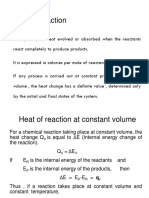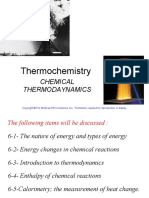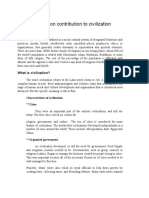5.3: Enthalpy: Learning Objectives
Uploaded by
Dhaba Abera5.3: Enthalpy: Learning Objectives
Uploaded by
Dhaba Abera5.
3: Enthalpy
Learning Objectives
To know the key features of a state function.
To use Hess’s law and thermochemical cycles to calculate enthalpy changes of chemical reactions.
Both heat and work represent energy transfer mechanisms. As discussed previously, the term "heat" refers to a process in
which a body (the contents of a tea kettle, for example) acquires or loses energy as a direct consequence of its having a
different temperature than its surroundings. Similarly, work refers to the transfer of energy that does not involve temperature
differences. Hence, work, like energy, can take various forms, the most familiar being mechanical and electrical.
Mechanical work arises when an object moves a distance Δx against an opposing force f :
wmechanical = f Δx (5.3.1)
Electrical work is done when a body having a charge q moves through a potential difference ΔV .
welectrical = qΔV (5.3.2)
The unit of work is Joules. Work, like heat, exists only when energy is being transferred. When two bodies are placed in
thermal contact and energy flows from the warmer body to the cooler one, this process is called “heat”. A transfer of energy to
or from a system by any means other than heat is called “work”.
Enthalpy as a Composite Function
To further understand the relationship between heat flow (q) and the resulting change in internal energy (ΔU ), we can look at
two sets of limiting conditions: reactions that occur at constant volume and reactions that occur at constant pressure. We will
assume that PV work is the only kind of work possible for the system, so we can substitute its definition (w=-P\Delta V\) into
the first Law of Thermodynamics (ΔU = q + w ) to obtain the following:
ΔU = q − P ΔV (5.3.3)
where the subscripts have been deleted.
If the reaction occurs in a closed vessel, the volume of the system is fixed, and ΔV is zero. Under these conditions, the heat
flow (often given the symbol qv to indicate constant volume) must equal ΔU:
qv = ΔU (5.3.4)
constant volume
At constant volume, no P V work can be done, and the change in the internal energy
of the system is equal to the amount of heat transferred from the system to the
surroundings or vice versa.
Many chemical reactions are not, however, carried out in sealed containers at constant volume but in open containers at a more
or less constant pressure of about 1 atm. The heat flow under these conditions is given the symbol q to indicate constant
p
pressure. Replacing q in Equation 5.3.4 by q and rearranging to solve for qp,
p
qp = ΔU + P ΔV (5.3.5)
constant pressure
Thus, at constant pressure, the heat flow for any process is equal to the change in the internal energy of the system plus the PV
work done.
Because conditions of constant pressure are so important in chemistry, a new state function called enthalpy (H) is defined as
H = U +PV (5.3.6)
At constant pressure, the change in the enthalpy of a system is as follows:
5/2/2021 5.3.1 CC-BY-NC-SA https://chem.libretexts.org/@go/page/21723
ΔH = ΔU + Δ(P V ) = ΔU + P ΔV (5.3.7)
Comparing the previous two equations shows that at constant pressure, the change in the enthalpy of a system is equal to the
heat flow: ΔH = q . This expression is consistent with our definition of enthalpy, where we stated that enthalpy is the heat
p
absorbed or produced during any process that occurs at constant pressure.
At constant pressure, the change in the enthalpy of a system is equal to the heat flow:
ΔH = q . p
Example 5.3.1
The molar enthalpy of fusion for ice at 0.0°C and a pressure of 1.00 atm is 6.01 kJ, and the molar volumes of ice and
water at 0°C are 0.0197 L and 0.0180 L, respectively. Calculate ΔH and ΔU for the melting of ice at 0.0°C.
Given: enthalpy of fusion for ice, pressure, and molar volumes of ice and water
Asked for: ΔH and ΔU for ice melting at 0.0°C
Strategy:
A. Determine the sign of q and set this value equal to ΔH.
B. Calculate Δ(PV) from the information given.
C. Determine ΔU by substituting the calculated values into Equation 5.3.7.
Solution
A Because 6.01 kJ of heat is absorbed from the surroundings when 1 mol of ice melts, q = +6.01 kJ. When the process is
carried out at constant pressure, q = qp = ΔH = 6.01 kJ.
B To find ΔU using Equation ??? , we need to calculate Δ(PV). The process is carried out at a constant pressure of 1.00
atm, so
Δ(P V ) = P ΔV = P (Vf − V ) = (1.00 atm)(0.0180 L − 0.0197 L) (5.3.8)
−3
= (−1.7 × 10 L ⋅ atm)(101.3 J/L ⋅ atm) = −0.0017 J (5.3.9)
C Substituting the calculated values of ΔH and PΔV into Equation 18.11,
ΔU = ΔH − PΔV = 6010 J − (−0.0017 J) = 6010 J = 6.01 kJ
Exercise 5.3.1
At 298 K and 1 atm, the conversion of graphite to diamond requires the input of 1.850 kJ of heat per mole of carbon. The
molar volumes of graphite and diamond are 0.00534 L and 0.00342 L, respectively. Calculate ΔH and ΔU for the
conversion of C (graphite) to C (diamond) under these conditions.
Answer a
ΔH = 1.85 kJ/mol
Answer b
ΔU = 1.85 kJ/mol
The Relationship between ΔH and ΔU
If ΔH for a reaction is known, we can use the change in the enthalpy of the system (Equation 5.3.7) to calculate its change in
internal energy. When a reaction involves only solids, liquids, liquid solutions, or any combination of these, the volume does
not change appreciably (ΔV = 0). Under these conditions, we can simplify Equation 5.3.7 to ΔH = ΔU. If gases are involved,
however, ΔH and ΔU can differ significantly. We can calculate ΔU from the measured value of ΔH by using the right side of
Equation 5.3.7 together with the ideal gas law, PV = nRT. Recognizing that Δ(PV) = Δ(nRT), we can rewrite Equation 5.3.7 as
follows:
5/2/2021 5.3.2 CC-BY-NC-SA https://chem.libretexts.org/@go/page/21723
ΔH = ΔU + Δ(P V ) = ΔU + Δ(nRT ) (5.3.10)
At constant temperature, Δ(nRT) = RTΔn, where Δn is the difference between the final and initial numbers of moles of gas.
Thus
ΔU = ΔH − RT Δn (5.3.11)
For reactions that result in a net production of gas, Δn > 0, so ΔU < ΔH. Conversely, endothermic reactions (ΔH > 0) that
result in a net consumption of gas have Δn < 0 and ΔU > ΔH. The relationship between ΔH and ΔU for systems involving
gases is illustrated in Example 5.3.2.
For reactions that result in a net production of gas, ΔU < ΔH. For endothermic reactions that result in a net consumption
of gas, ΔU > ΔH.
Example 5.3.2 : The Relationship Between ΔH and ΔU in Gas Evolving Reactions
The combustion of graphite to produce carbon dioxide is described by the equation
C(graphite,s) + O2(g) → C O2(g) (5.3.12)
At 298 K and 1.0 atm, ΔH = −393.5 kJ/mol of graphite for this reaction, and the molar volume of graphite is 0.0053 L.
What is ΔU for the reaction?
Given: balanced chemical equation, temperature, pressure, ΔH, and molar volume of reactant
Asked for: ΔU
Strategy:
A. Use the balanced chemical equation to calculate the change in the number of moles of gas during the reaction.
B. Substitute this value and the data given into Equation 5.3.11 to obtain ΔU.
Solution
A In this reaction, 1 mol of gas (CO2) is produced, and 1 mol of gas (O2) is consumed. Thus Δn = 1 − 1 = 0.
B Substituting this calculated value and the given values into Equation 5.3.11,
ΔU=ΔH−RTΔn=(−393.5 kJ/mol)−[8.314 J/(mol⋅K)](298 K)(0)
=(−393.5 kJ/mol)−(0 J/mol)=−393.5 kJ/mol
To understand why only the change in the volume of the gases needs to be considered, notice that the molar volume of
graphite is only 0.0053 L. A change in the number of moles of gas corresponds to a volume change of 22.4 L/mol of gas
at standard temperature and pressure (STP), so the volume of gas consumed or produced in this case is (1)(22.4 L) = 22.4
L, which is much, much greater than the volume of 1 mol of a solid such as graphite.
Exercise 5.3.2
Calculate ΔU for the conversion of oxygen gas to ozone at 298 K:
3 O2 (g) → 2 O3 (g). (5.3.13)
The value of ΔH for the reaction is 285.4 kJ.
Answer
288 kJ
As Example 5.3.2 illustrates, the magnitudes of ΔH and ΔU for reactions that involve gases are generally rather similar, even
when there is a net production or consumption of gases.
Summary
5/2/2021 5.3.3 CC-BY-NC-SA https://chem.libretexts.org/@go/page/21723
Enthalpy is a state function, and the change in enthalpy of a system is equal to the sum of the change in the internal energy of
the system and the PV work done. Enthalpy is a state function whose change indicates the amount of heat transferred from a
system to its surroundings or vice versa, at constant pressure. The change in the internal energy of a system is the sum of the
heat transferred and the work done. At constant pressure, heat flow (q) and internal energy (U) are related to the system’s
enthalpy (H). The heat flow is equal to the change in the internal energy of the system plus the PV work done. When the
volume of a system is constant, changes in its internal energy can be calculated by substituting the ideal gas law into the
equation for ΔU.
5/2/2021 5.3.4 CC-BY-NC-SA https://chem.libretexts.org/@go/page/21723
You might also like
- (Oxford World's Classics) Euripides, James Morwood, Edith Hall - The Trojan Women and Other Plays-Oxford University Press (2009) PDF92% (12)(Oxford World's Classics) Euripides, James Morwood, Edith Hall - The Trojan Women and Other Plays-Oxford University Press (2009) PDF939 pages
- Chapter 5 Thermochemistry Test With SolutionsNo ratings yetChapter 5 Thermochemistry Test With Solutions14 pages
- The Notion of Freedom in Krishnamurti and SartreNo ratings yetThe Notion of Freedom in Krishnamurti and Sartre10 pages
- Equailibriu in Chem Rxn Thermochemistry Ch6.Ppt [Compatibility Mode]-1No ratings yetEquailibriu in Chem Rxn Thermochemistry Ch6.Ppt [Compatibility Mode]-134 pages
- Lecture 2b - 3 - Heat Capacities - Enthalpy - Hess - Online - Class - 2020No ratings yetLecture 2b - 3 - Heat Capacities - Enthalpy - Hess - Online - Class - 202028 pages
- Thermochemistry: Study of Heat Change in Chemical ReactionsNo ratings yetThermochemistry: Study of Heat Change in Chemical Reactions34 pages
- Thermochemistry: Energy Changes in Chemical ReactionsNo ratings yetThermochemistry: Energy Changes in Chemical Reactions6 pages
- Thermodynamic: Intennal Energy and Comparison Between Enthalpy H and Internal Energy ENo ratings yetThermodynamic: Intennal Energy and Comparison Between Enthalpy H and Internal Energy E12 pages
- Chapter 1. First Law of Thermodynamics EnthalpyNo ratings yetChapter 1. First Law of Thermodynamics Enthalpy31 pages
- Class 11 Ncert Thermodynamics Solutions PDFNo ratings yetClass 11 Ncert Thermodynamics Solutions PDF12 pages
- 1-Thermodynamics and Chemical Change_a7c5fa6b4da9e4e2423c76663bf6e94cNo ratings yet1-Thermodynamics and Chemical Change_a7c5fa6b4da9e4e2423c76663bf6e94c67 pages
- Thermochemistry: Chemical ThermodaynamicsNo ratings yetThermochemistry: Chemical Thermodaynamics36 pages
- Dell PowerEdge R730 and R730xd Technical Guide v1 7 CompressedNo ratings yetDell PowerEdge R730 and R730xd Technical Guide v1 7 Compressed66 pages
- Religion's Contribution To Civilization-1No ratings yetReligion's Contribution To Civilization-112 pages
- 8130.1 Application For Export Certificate of AirworthinessNo ratings yet8130.1 Application For Export Certificate of Airworthiness2 pages
- Burying The Dead': Making Muslim Space in Britain : Humayun AnsariNo ratings yetBurying The Dead': Making Muslim Space in Britain : Humayun Ansari22 pages
- Ash Handling System: in A 210 M.W Boiler, The Coal Consumption Is 3,500 M.T S Per Day The Ash Content Is 1,400 M.T SNo ratings yetAsh Handling System: in A 210 M.W Boiler, The Coal Consumption Is 3,500 M.T S Per Day The Ash Content Is 1,400 M.T S22 pages
- Pump Specification Weights and Measurements: Dorothy WaiteNo ratings yetPump Specification Weights and Measurements: Dorothy Waite14 pages
- Since 1989 Da Milano Is An Integral Leather Brand That Manufactures and Retails High End Leather Bags and Accessories For Both Men and Women100% (1)Since 1989 Da Milano Is An Integral Leather Brand That Manufactures and Retails High End Leather Bags and Accessories For Both Men and Women21 pages
- Health6 - Q4 - ImportanceOfConsumerHealthNo ratings yetHealth6 - Q4 - ImportanceOfConsumerHealth22 pages
- Million-Day Gregorian-Julian Calendar - Notes100% (1)Million-Day Gregorian-Julian Calendar - Notes10 pages
- (Oxford World's Classics) Euripides, James Morwood, Edith Hall - The Trojan Women and Other Plays-Oxford University Press (2009) PDF(Oxford World's Classics) Euripides, James Morwood, Edith Hall - The Trojan Women and Other Plays-Oxford University Press (2009) PDF
- Equailibriu in Chem Rxn Thermochemistry Ch6.Ppt [Compatibility Mode]-1Equailibriu in Chem Rxn Thermochemistry Ch6.Ppt [Compatibility Mode]-1
- Lecture 2b - 3 - Heat Capacities - Enthalpy - Hess - Online - Class - 2020Lecture 2b - 3 - Heat Capacities - Enthalpy - Hess - Online - Class - 2020
- Thermochemistry: Study of Heat Change in Chemical ReactionsThermochemistry: Study of Heat Change in Chemical Reactions
- Thermochemistry: Energy Changes in Chemical ReactionsThermochemistry: Energy Changes in Chemical Reactions
- Thermodynamic: Intennal Energy and Comparison Between Enthalpy H and Internal Energy EThermodynamic: Intennal Energy and Comparison Between Enthalpy H and Internal Energy E
- 1-Thermodynamics and Chemical Change_a7c5fa6b4da9e4e2423c76663bf6e94c1-Thermodynamics and Chemical Change_a7c5fa6b4da9e4e2423c76663bf6e94c
- Dell PowerEdge R730 and R730xd Technical Guide v1 7 CompressedDell PowerEdge R730 and R730xd Technical Guide v1 7 Compressed
- 8130.1 Application For Export Certificate of Airworthiness8130.1 Application For Export Certificate of Airworthiness
- Burying The Dead': Making Muslim Space in Britain : Humayun AnsariBurying The Dead': Making Muslim Space in Britain : Humayun Ansari
- Ash Handling System: in A 210 M.W Boiler, The Coal Consumption Is 3,500 M.T S Per Day The Ash Content Is 1,400 M.T SAsh Handling System: in A 210 M.W Boiler, The Coal Consumption Is 3,500 M.T S Per Day The Ash Content Is 1,400 M.T S
- Pump Specification Weights and Measurements: Dorothy WaitePump Specification Weights and Measurements: Dorothy Waite
- Since 1989 Da Milano Is An Integral Leather Brand That Manufactures and Retails High End Leather Bags and Accessories For Both Men and WomenSince 1989 Da Milano Is An Integral Leather Brand That Manufactures and Retails High End Leather Bags and Accessories For Both Men and Women

























































































